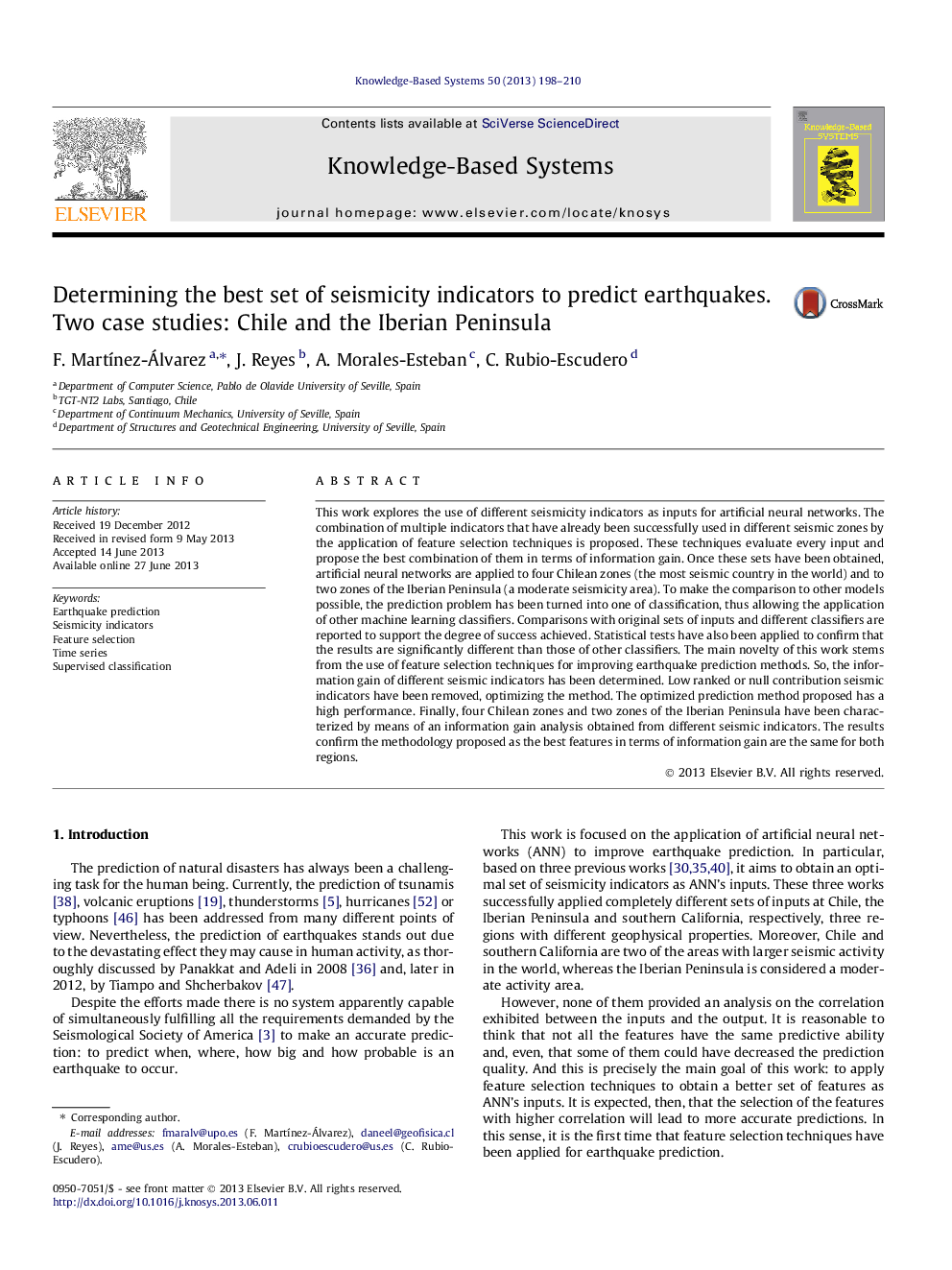| کد مقاله | کد نشریه | سال انتشار | مقاله انگلیسی | نسخه تمام متن |
|---|---|---|---|---|
| 6862804 | 677027 | 2013 | 13 صفحه PDF | دانلود رایگان |
عنوان انگلیسی مقاله ISI
Determining the best set of seismicity indicators to predict earthquakes. Two case studies: Chile and the Iberian Peninsula
ترجمه فارسی عنوان
تعیین بهترین شاخص های لرزه ای برای پیش بینی زلزله. دو مطالعه موردی: شیلی و شبه جزیره ایبرین
دانلود مقاله + سفارش ترجمه
دانلود مقاله ISI انگلیسی
رایگان برای ایرانیان
کلمات کلیدی
پیش بینی زلزله، شاخص های لرزه خیزی، انتخاب ویژگی، سری زمانی، طبقه بندی تحت نظارت،
ترجمه چکیده
این کار به بررسی استفاده از شاخص های لرزه ای مختلف به عنوان ورودی برای شبکه های عصبی مصنوعی می پردازد. ترکیبی از چندین شاخص که قبلا با استفاده از تکنیک های انتخاب ویژگی در مناطق مختلف لرزه ای مورد استفاده قرار گرفته اند پیشنهاد شده است. این تکنیک ها هر ورودی را ارزیابی می کند و بهترین ترکیب آنها را از نظر افزایش اطلاعات پیشنهاد می دهد. هنگامی که این مجموعه ها به دست آمده، شبکه های عصبی مصنوعی به چهار منطقه شیلی (بیشترین کشور لرزه ای در جهان) و دو ناحیه شبه جزیره ایبرین (ناحیه لرزه ای متوسط) اعمال می شوند. برای مقایسه با سایر مدل های ممکن، مشکل پیش بینی شده به یکی از طبقه بندی تبدیل شده است، بنابراین اجازه می دهد تا استفاده از دیگر طبقه بندی های یادگیری ماشین. گزارش ها نشان می دهد که مقایسات با مجموعه های اصلی ورودی ها و طبقه بندی های مختلف، از درجه موفقیت موفقیت آمیز حمایت می کنند. آزمون های آماری نیز برای تایید اینکه نتایج به طور قابل توجهی متفاوت از سایر طبقه بندی ها است، استفاده شده است. نوآوری اصلی این کار از استفاده از تکنیک های انتخاب ویژگی برای بهبود روش های پیش بینی زلزله ناشی می شود. بنابراین، به دست آوردن اطلاعات شاخص های لرزه ای مختلف تعیین شده است. شاخص های لرزه ای کمترین رتبه بندی و یا صفر حذف شده اند، بهینه سازی روش. روش پیش بینی بهینه شده پیشنهادی عملکرد بالایی دارد. در نهایت، چهار منطقه شیلی و دو ناحیه شبه جزیره ایبرین با استفاده از تجزیه و تحلیل به دست آمده از شاخص های مختلف لرزه ای مشخص شده اند. نتایج به دست آمده نشان می دهد که روش پیشنهادی به عنوان بهترین ویژگی ها از نظر به دست آوردن اطلاعات برای هر دو منطقه یکسان است.
موضوعات مرتبط
مهندسی و علوم پایه
مهندسی کامپیوتر
هوش مصنوعی
چکیده انگلیسی
This work explores the use of different seismicity indicators as inputs for artificial neural networks. The combination of multiple indicators that have already been successfully used in different seismic zones by the application of feature selection techniques is proposed. These techniques evaluate every input and propose the best combination of them in terms of information gain. Once these sets have been obtained, artificial neural networks are applied to four Chilean zones (the most seismic country in the world) and to two zones of the Iberian Peninsula (a moderate seismicity area). To make the comparison to other models possible, the prediction problem has been turned into one of classification, thus allowing the application of other machine learning classifiers. Comparisons with original sets of inputs and different classifiers are reported to support the degree of success achieved. Statistical tests have also been applied to confirm that the results are significantly different than those of other classifiers. The main novelty of this work stems from the use of feature selection techniques for improving earthquake prediction methods. So, the information gain of different seismic indicators has been determined. Low ranked or null contribution seismic indicators have been removed, optimizing the method. The optimized prediction method proposed has a high performance. Finally, four Chilean zones and two zones of the Iberian Peninsula have been characterized by means of an information gain analysis obtained from different seismic indicators. The results confirm the methodology proposed as the best features in terms of information gain are the same for both regions.
ناشر
Database: Elsevier - ScienceDirect (ساینس دایرکت)
Journal: Knowledge-Based Systems - Volume 50, September 2013, Pages 198-210
Journal: Knowledge-Based Systems - Volume 50, September 2013, Pages 198-210
نویسندگان
F. MartÃnez-Álvarez, J. Reyes, A. Morales-Esteban, C. Rubio-Escudero,
